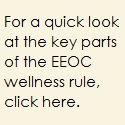This week, a federal judge had some scathing words for the Equal Employment Opportunity Commission as he tossed back its rules on the wellness program incentives telling it to rethink the whole thing.
Remind me: What are these incentive rules?
Back in 2016, the EEOC passed new regulations impacting wellness programs. Among other things, them jawns provide that, if a wellness program is  open only to employees enrolled in a particular health insurance plan, then the maximum allowable incentive an employer can offer is 30% of the total cost for self-only coverage of the plan.
open only to employees enrolled in a particular health insurance plan, then the maximum allowable incentive an employer can offer is 30% of the total cost for self-only coverage of the plan.
Back in October of last year, the AARP was like, screw all that, and filed a federal lawsuit in which it argued that the 30% incentives were inconsistent with the “voluntary” requirements of the ADA and GINA, and that employees who cannot afford to pay a 30% increase in premiums will be forced to disclose their protected information when they otherwise would choose not to do so.
Initially, the federal court denied the AARP’s request for an injunction. Tuesday, the AARP drank the EEOC’s milkshake.
In a dense decision, Judge John Bates concluded that there was “nothing… that explains the (EEOC’s) conclusion that the 30% incentive level is the appropriate measure for voluntariness.”
The court added that the “interpretation the agency adopted — the 30% incentive level — is actually not consistent with HIPAA.” Therefore, “the ‘voluntary’ provision of the ADA to permit incentives of up to 30% is thus deeply flawed…(and) the Court can find nothing in the administrative record — or the final rule — to indicate that the agency considered any factors that are actually relevant to the voluntariness question.”
Then Judge Bates kicked it up a notch, by highlighting the “EEOC’s failure to engage meaningfully with the text and purpose of the ADA”:
“Having chosen to define “voluntary” in financial terms—30% of the cost of self-only coverage—the agency does not appear to have considered any factors relevant to the financial and economic impact the rule is likely to have on individuals who will be affected by the rule. For example, commenters pointed out that, based on the average annual cost of premiums in 2014, a 30% penalty for refusing to provide protected information would double the cost of health insurance for most employees. At around $1800 a year, this is the equivalent of several months’ worth of food for the average family, two months of child care in most states and roughly two months’ rent.”
Judge Bates also gave the EEOC’s GINA rule the back of the hand, because it “suffers from the same problems as the ADA rule, in that EEOC did not adequately explain the basis for its decision to interpret GINA’s ‘voluntary’ provision as permitting the 30% incentive level.”
What the court ordered
As a remedy, the Court determined that vacating the EEOC’s rules altogether would “likely to have significant disruptive consequences.” That is “employers who adopted incentives would be faced with the possibility that their current health plans are illegal; at best, employers would once again be left in limbo as to what is permitted and what is not with regard to incentives.”
Instead, the court remanded them to the EEOC for “reconsideration.” And you guys are just going to have to hold tight to see what the agency does with them.
This article first appeared on The Employer Handbook.
